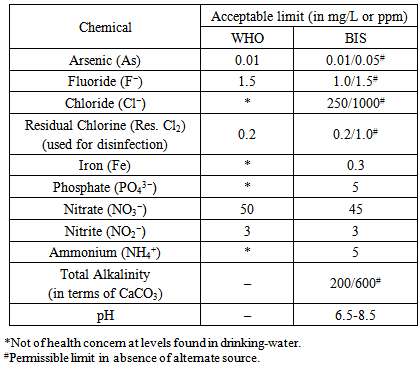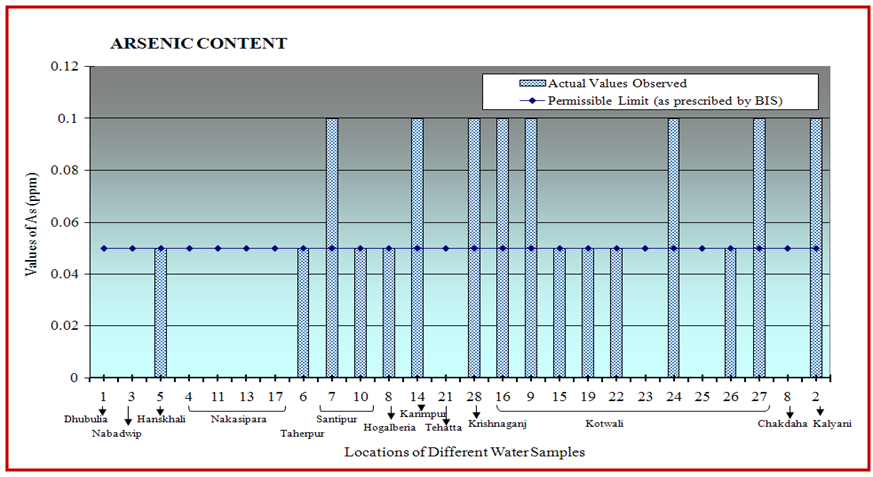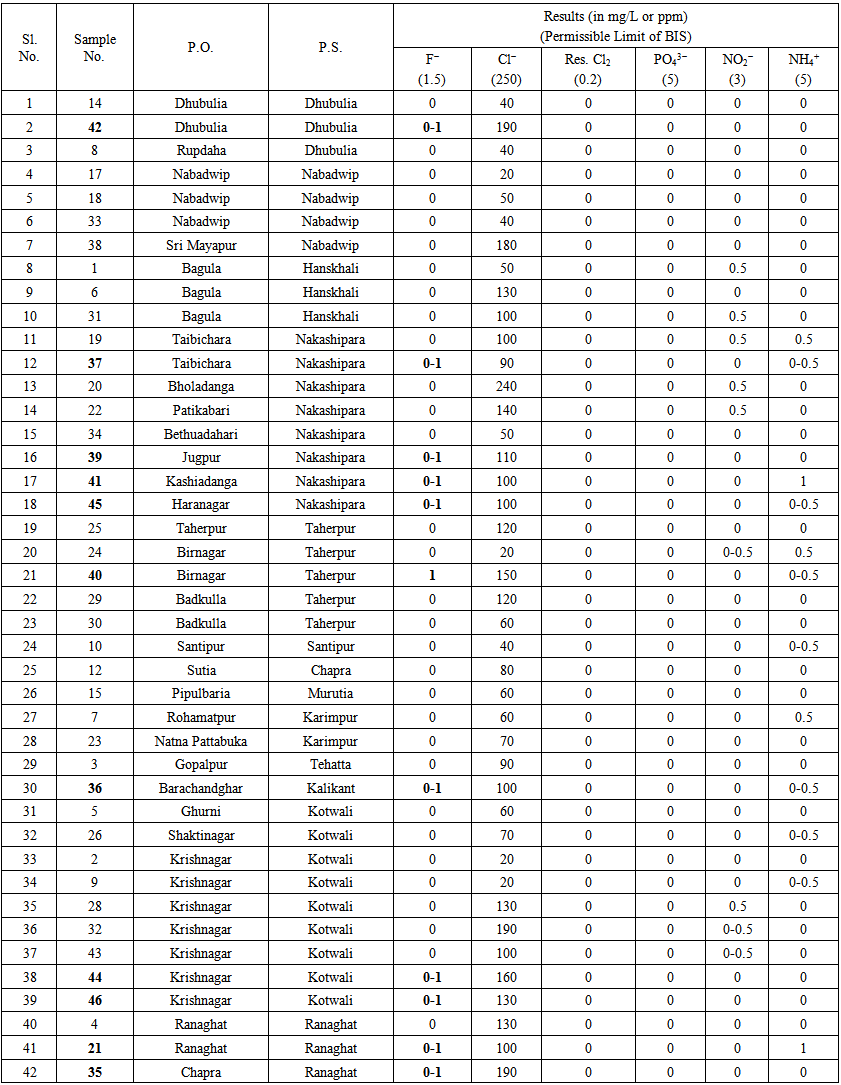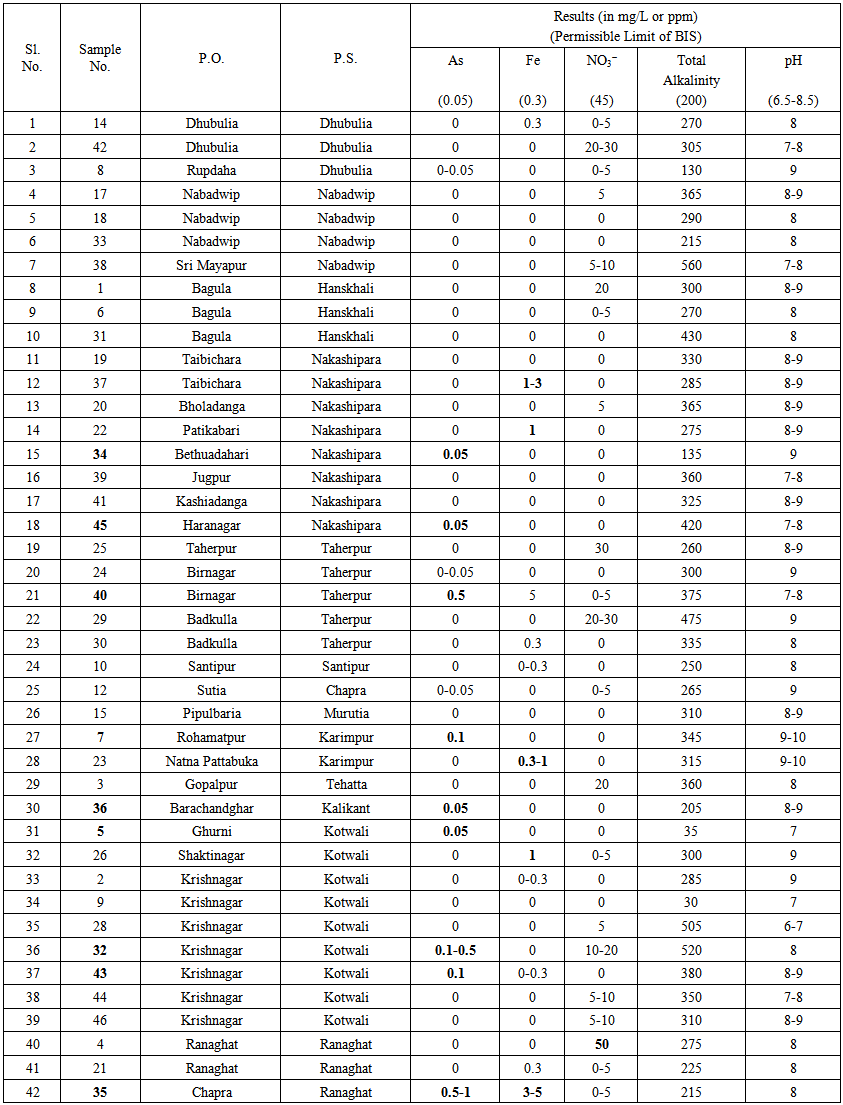Ajanta Mukherji
Department of Chemistry, Krishnagar Government College, Krishnagar, Nadia, West Bengal, Pin – 741101, India
Correspondence to: Ajanta Mukherji, Department of Chemistry, Krishnagar Government College, Krishnagar, Nadia, West Bengal, Pin – 741101, India.
| Email: |  |
Copyright © 2015 Scientific & Academic Publishing. All Rights Reserved.
Abstract
Drinking-water samples collected in 2012 and 2013 from different households in Nadia district were analysed using commercially available water testing kits. The samples were tested for 11 parameters – arsenic, fluoride, chloride, residual chlorine, iron, phosphate, nitrate, nitrite, ammonium, total alkalinity and pH. The results for 68 samples serve as an indicator of the quality of drinking-water in various areas of Nadia for these two years.
Keywords:
Drinking-water, Chemical contaminants, Water testing kits
Cite this paper: Ajanta Mukherji, Analysis of Drinking-water in Nadia District for Chemical Contaminants: Some Preliminary Findings, International Journal of Ecosystem, Vol. 5 No. 3A, 2015, pp. 18-28. doi: 10.5923/c.ije.201501.04.
1. Introduction
The World Health Organisation (WHO) “Guidelines for drinking-water quality” describes “safe drinking-water” as a quality of water that is acceptable for lifelong consumption. [1] Two major contaminants in water that can cause serious health-problems are certain harmful microbes (bacteria, virus, protozoa, etc.) and chemicals. The Guidelines have enlisted nearly a 100 chemicals (including inorganic anions, metals, various organic compounds and their metabolites) that are of health significance in drinking-water. Most of them, with a few exceptions, are of health concern only after extended exposure of years rather than months. [2] However, water being a necessary component of life, people knowingly or unknowingly consume contaminated water and the long-term effects of the chemicals when detected are often life-threatening. Hence, it is desirable that water for drinking be routinely screened for any hazardous contaminants and purified accordingly.It is well-established that, of the 100 or so harmful chemical contaminants, the most toxic and widely prevalent in Nadia district, in West Bengal, is arsenic. There are several detailed studies about the occurrence and effects of arsenic contamination in West Bengal, in general, and Nadia district, in particular. [3-5] Early detection and avoidance of consumption of arsenic-contaminated water is the key to saving lives. This is also true for other chemical contaminants like fluoride, nitrate, etc. The WHO has set some “acceptable limits” or values of the concentrations of the chemical contaminants which do not result in any significant risk to health over a lifetime of consumption. Hence, it is better to know whether a particular chemical is present above the acceptable limit in a water sample, rather than the absolute value of the concentration. In other words, chemical tests, which can easily determine the concentration of the ions above the acceptable limit with fair accuracy and within a short time are required, so that they can be performed over large number of samples, both in the field (rural areas) and in laboratories.Water testing kits, available commercially, provide a low cost, rapid and simple means to detect inorganic ions with easy-to-follow instructions. Their usefulness and limitations are given in the Guidelines. [6] The results are semi-quantitative, that is, the chemical reactions produce observable changes - either different colours (e.g. in case of pH) of the water sample or different intensities of a particular colour (e.g. yellow in case of arsenic), each corresponding to a particular range of concentration of the ion. The intensity of colour is finally matched by eye estimation to the range of concentration of the ion given in the colour chart. The results are fairly reliable and serve the purpose to know whether the concentration of a particular ion is above acceptable limit or not, by observing the colour intensity. Once it is determined that a sample is in the “unsafe range”, it may be further tested by sophisticated analytical methods to determine the concentration accurately.
2. Results and Discussion
The present study was done primarily with an aim to determine the quality of drinking-water consumed by the students of Krishnagar Government College and their families in Nadia district. The water samples were collected by two consecutive batches of 1st Year Chemistry Honours and General students of the College in 2012 and 2013 from their households or neighbourhood, as the source of water consumption may be, and analysed in the laboratory. However, since the occurrence of the students in the college is a random choice, the study may be considered a random study of the quality of drinking-water of the households in Nadia district and the results give an overview of the areas with either prevalent or future risks.Water testing kits for 11 parameters were used for the study. The parameters tested were arsenic, fluoride, chloride, residual chlorine, iron, phosphate, nitrate, nitrite, ammonium, total alkalinity and pH. Table 1 gives the acceptable limits of these ions according to the WHO and the Indian standards, as prescribed by the BIS. For some ions the WHO has not established a guideline value for reason mentioned below the Table.In 2012, water samples were collected from 26 households in Nadia district and analysed. For ease of analysis, these individual households have been grouped into 13 different localities identified by the corresponding Police Stations. Further, the results have been grouped into two categories – some of the parameters tested were found to be consistently within acceptable limits across all samples and some of the parameters showed trends for exceeding the acceptable limit. The parameters which were found to be within acceptable limit for 2012 are given in Table 2. These are fluoride, chloride, residual chlorine, phosphate, nitrite and ammonium ion. Water sample collected from a particular household is denoted by a unique sample number, which contains the details of the address. For sake of simplicity, only the sample numbers, post office names and police stations are given.Table 1.
 |
| |
|
 | Table 2. Parameters found to be within acceptable limits in samples analysed (2012) |
From an analysis of the results obtained in Table 2, the following conclusions could be drawn. Chloride, residual chlorine, phosphate, nitrite and ammonium ions were found to be well within the acceptable limit, hence, the drinking-water of the households of Nadia district could be said to be safe from the risk of these ions. However, nine of the samples tested for fluoride, namely Nos. 10, 18, 21, 28, 16, 24, 25, 27 and 8, showed presence of the ion near the threshold value. Hence, samples from these localities, namely, Nrishinghapur, Bagchi Jamsherpur, Taranipur, Sakdaha, Kulgachhi, Krishnagar and Chakdaha should be monitored routinely for future risks.In Table 3, the parameters which were found to be above acceptable limit for 2012 are given. These are arsenic, iron, nitrate ion, total alkalinity and pH. | Table 3. Parameters found to exceed acceptable limits in samples analysed (2012) |
An analysis of the results in Table 3 revealed that eight of the samples tested (Nos. 7, 10, 14, 28, 16, 9, 24, 27 and 2) showed high levels of arsenic. Seven other samples (Nos. 5, 6, 18, 15, 19, 22 and 26) showed arsenic levels above the WHO standard and hence, were unsafe. Two of these samples, namely, 6 and 15 from Badkulla and Krishnagar respectively, also showed high levels of nitrate. Levels of iron were found to be higher than acceptable limit in eight samples (Nos. 10, 18, 14, 21, 28, 16, 9 and 24) while nearly all of the samples tested had high total alkalinity and pH range.The source of water for all the samples, that is, whether from deep tube-well or municipality were noted. Also, in case of tube-wells, the depths were noted. These data have been furnished in Table 4. | Table 4. Source of water for the samples collected in 2012 |
From the above Table, however, no distinct correlation could be drawn regarding the depth of tube-well and presence of contaminant above the permissible limit.The status of arsenic, iron and nitrate content in different water samples in Nadia district under different locations in 2012 have also been shown schematically with the help of bar charts in Figures 1, 2 and 3 respectively. | Figure 1. |
 | Figure 2. |
 | Figure 3. |
In a similar study in 2013, water samples were collected from 42 households in Nadia district and analysed. These were collected from 13 different localities identified by the corresponding Police Stations. The results for the parameters which were found to be within acceptable limits have been shown in Table 5 in the next page. | Table 5. Parameters found to be within acceptable limits in samples analysed (2013) |
From Table 5, it is found that in the samples analysed in 2013, all of them were safe with respect to chloride, residual chlorine, phosphate, nitrite and ammonium ions. However, eleven samples (Nos. 42, 37, 39, 41, 45, 40, 36, 44, 46, 21 and 35) were near the threshold limit with respect to fluoride and hence, samples from these areas in Nadia, namely, Dhubulia, Taibichara, Jugpur, Kashiadanga, Haranagar, Birnagar, Barachandghar, Krishnagar and Ranaghat require close monitoring in the future.The results for the parameters which were found to be above acceptable limits have been shown in Table 6 below. | Table 6. Parameters found to exceed acceptable limits in samples analysed (2013) |
From Table 6, it could be concluded that nine of the samples (Nos. 34, 45, 40, 7, 36, 5, 32, 42 and 35) showed very high levels of arsenic, while three more samples (Nos. 8, 24 and 12) showed arsenic levels near threshold value. Only one sample (No. 4) showed high level of nitrate. Levels of iron were found to be higher than acceptable limit in five samples (Nos. 37, 22, 23, 26 and 35), while nearly all of the samples had high total alkalinity and pH range.The source of water for the above samples and the depths of tube-wells are given in Table 7. | Table 7. Source of water for the samples collected in 2013 |
As before, no clear-cut correlation could be drawn regarding the depth of tube-well and the concentration of the ions.The status of arsenic, iron and nitrate content in different water samples in Nadia district under different locations in 2013 have been shown pictorially with the help of bar charts in Figures 4, 5 and 6 respectively. | Figure 4. |
 | Figure 5. |
 | Figure 6. |
3. Conclusions
In the present study, testing of 68 water samples from different households of Nadia district for 2012 and 2013 was done by commercially available Water Testing kits. This resulted in the detection and quantification (in a given range as per eye-estimation) of harmful chemicals in a convenient and rapid manner. The locations in Nadia district with drinking-water containing these chemicals above permissible limits were easily detected. However, monitoring of drinking-water is a not a one-time process, but a continuous one. Water should be routinely screened for harmful chemicals since their concentrations from a particular source (e.g. groundwater) could increase with time. Hence, the data have been presented as ‘preliminary findings’ and further research is being continued in order to get consistent results from the areas indicated as having “unsafe” drinking-water from these findings.
4. Experimental Details
Water Testing Kits were purchased from NICE Chemicals Pvt. Ltd., Kochi, Kerala. Five different kits, either for a single ion or more than one ion (combination kit) were used – one for Arsenic, one for Iron and Phosphate, one for Fluoride, Chloride and Residual Chlorine, one for Nitrate, Nitrite and Ammonium and one for Total Alkalinity and pH. Nearly 200 ml of each water sample was collected in a 250 ml plastic bottle for sample collection and analysed as such within 2 days. The samples were analysed strictly following the procedure given in each testing kit and using the reagents provided in the kit.
ACKNOWLEDGEMENTS
The Water Testing Kits were purchased from UGC-CPE XII Plan Grant of the College. The author would like to thank the Department of Chemistry for laboratory facilities and the students of 1st Year Chemistry Honours (2011 and 2012) and Chemistry General (2012) for sample collection and their active participation in the study. Sincere thanks are also due to Dr. Rajashree Dasgupta, PG Dept. of Geography, Krishnagar Govt. College for preparing the Figures and providing valuable suggestions.
References
| [1] | “Guidelines for Drinking-water Quality”, World Health Organization, 3rd Edition, incorporating the 1st and 2nd Addenda, Vol. 1, Recommendations, Geneva, 2008 [ISBN 978-92-4-154761-1 (Web)], p. 1. |
| [2] | “Chemical Aspects”, In “Guidelines for Drinking-water Quality”, Chapter 8, World Health Organization, 3rd Edition, 2008, pp. 145-196g. |
| [3] | “Arsenic in groundwater in seven districts of West Bengal, India – The biggest arsenic calamity in the world”, B. K. Mandal, T. Roy Chowdhury, G. Samanta, G. K. Basu, P. P. Chowdhury, C. R. Chanda, D. Lodh, N. K. Karan, R. K. Dhar, D. K. Tamili, D. Das, K. C. Saha and D. Chakraborti, Current Science, 1996, 70, 976-986. |
| [4] | “Status of groundwater arsenic contamination in the state of West Bengal, India: A 20-year study report”, D. Chakraborti, B. Das, M. M. Rahman, U. K. Chowdhury, B. Biswas, A. B. Goswami, B. Nayak, A. Pal, M. K. Sengupta, S. Ahamed, A. Hossain, G. Basu, T. Roychowdhury and D. Das, Mol. Nutr. Food Res., 2009, 53, 542-551. |
| [5] | “Arsenic contamination of groundwater and its health impact on population of District of Nadia, West Bengal, India”, D. N. Guha Mazumder, A. Ghosh, K. K. Majumdar, N. Ghosh, C. Saha and R. N. Guha Mazumder, Indian J. Community Med., 2010, 35, 331-338. |
| [6] | “Guidelines for Drinking-water Quality”, World Health Organization, 4th Edition, 2011 [ISBN 978-92-4-154761-1 (Web)], p. 170. |













 Abstract
Abstract Reference
Reference Full-Text PDF
Full-Text PDF Full-text HTML
Full-text HTML